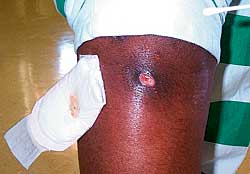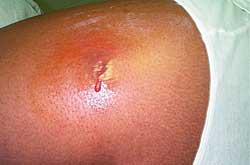MRSA Staph Infections: Coming to a Workplace Near You
A strain of antibiotic-resistant staph bacteria has recently moved out of the hospital setting and into the general public.
- By Dr. Mark Christensen
- Apr 01, 2007
 IF you have not heard of MRSA (methicillin resistant staphylococcus
aureus) yet, you will very soon. MRSA (it is generally verbalized as
mersa) used to be found only in hospitals. But as a result of 50 years of
prescribing penicillin-related antibiotics for infections, the bacteria that
cause staph infections have mutated and grown resistant to common antibiotics.
Those resistant bacteria, MRSA, have presented themselves in the form of a new
"super bug" that has moved quickly into the general public. And it's a super bug
that's much more difficult to kill than previous staph bacteria.
IF you have not heard of MRSA (methicillin resistant staphylococcus
aureus) yet, you will very soon. MRSA (it is generally verbalized as
mersa) used to be found only in hospitals. But as a result of 50 years of
prescribing penicillin-related antibiotics for infections, the bacteria that
cause staph infections have mutated and grown resistant to common antibiotics.
Those resistant bacteria, MRSA, have presented themselves in the form of a new
"super bug" that has moved quickly into the general public. And it's a super bug
that's much more difficult to kill than previous staph bacteria.
The MRSA being discussed is referred to as community-acquired MRSA (CA-MRSA).
There is also hospital-acquired MRSA (HA-MRSA), but the present focus is on the
community-acquired form. Although a MRSA staph infection can lead to lost time
for workers--and in severe cases, death--there are steps that can be taken to
try to prevent staph infections in work environments. But first, let's take a
look at this new super bug.
- What are some of the symptoms of a MRSA staph infection?
The Centers for Disease Control (CDC) says that community-acquired MRSA is
"most often present as a skin or soft tissue infection such as a boil or
abscess." People with a minor infection commonly describe it as a "spider bite."
The affected area can be swollen and red in color and have pus or other drainage
present.
If not treated immediately, MRSA staph infections can continue their march
all over the body and even infect the heart and lungs and cause pneumonia. If
the lungs become infected, symptoms such as shortness of breath, chills, and
fever could appear. Medical attention should be sought if there is any
indication that a MRSA infection is present. Pay special attention to pus-filled
infections.
According to Dr. David Bearden, a clinician specializing in infectious
diseases, "Recent reports suggest that 60 percent of pus-forming skin infections
seen in hospital emergency rooms across the country are caused by MRSA."
Staph bacteria, including MRSA, can live on the skin. Therefore, something as
simple as shaking hands can spread the bacteria. Any open wound is a potential
entry point for MRSA. Hard surfaces have the potential to host the spiteful
bacteria. So, walls, floors, and similar surfaces may carry MRSA. Crowded living
conditions and poor hygiene are contributors to the spread of bacteria,
including MRSA.
The CDC says MRSA is "transmitted most frequently by direct skin-to-skin
contact." Any situation where large groups live or work together may be a
breeding ground for the offending organisms. Gear and tools can harbor the
bacteria. Even weights and equipment at a fitness center can transmit MRSA.
An Ugly Beast Comes Out of Hiding
"MRSA has been an important
infection-causing bug in the hospital for over 20 years. It was nearly unheard
of as an infection cause outside of the community until the late 1990s. Even
then, it was a rare event," says Bearden. "The rapid rise from only sporadic
reports to primary pathogen is alarming."
 Yes, the brisk pace at which MRSA moved from hospitals to the mass population
has caught many off guard. It used to be that hospitals and long-term care
facilities were where staph infections occurred, but not anymore. Now, according
to the CDC, the infections "occur in otherwise healthy, non-hospitalized persons
without contact with healthcare personnel or other colonized patients."
Yes, the brisk pace at which MRSA moved from hospitals to the mass population
has caught many off guard. It used to be that hospitals and long-term care
facilities were where staph infections occurred, but not anymore. Now, according
to the CDC, the infections "occur in otherwise healthy, non-hospitalized persons
without contact with healthcare personnel or other colonized patients."
Public awareness of community-acquired MRSA first began to take shape in the
late 1990s, when the CDC released a report chronicling four MRSA-related deaths
of children in the Midwest. None of the four children had been hospitalized
within the previous year. At the time, the CDC said that the four cases
"demonstrate the potential severity of community acquired MRSA infections."
After the report, community-acquired MRSA kept a low profile. Cases in hospitals
grew rapidly, but the beast known as community-acquired MRSA stayed out of sight
until about 2000. At that point, a trickle of cases started appearing. However,
in the past few years, the number of staph infections in the general population
due to MRSA has exploded. MRSA is a ticking time bomb, ready to detonate.
The Infectious Diseases Society of America makes it crystal clear how
concerned it is about infectious diseases such as MRSA. "These are
life-threatening drug-resistant infections, and we're seeing them every day,"
says IDSA President Martin J. Blaser, MD. "What is worse is that our ammunition
is running out and there are no reinforcements in sight."
Penicillin-related antibiotics do not kill MRSA. Common triple-antibiotic
ointments that are found on drugstore shelves and in the first aid kits across
the country also don't kill MRSA. So treating wounds in the old-fashioned way
may not kill the infection-causing bacteria.
Even Our Healthiest Citizens are Getting Infected
In parts of the United States, stories of famous athletes getting MRSA infections have made
headlines. The St. Louis Rams and the Cleveland Browns have had high-profile
cases of MRSA infections within their football programs. Part of the challenge
for professional football players, and collegiate players for that matter, is
the fact that MRSA bacteria can enter the body through a minor wound such as a
turf burn. The MRSA bacteria can live on towels, walls, floors, and other
surfaces--such as, theoretically, artificial turf. And even though these men are
world-class athletes, a staph infection can debilitate one of them within
hours.
Brian Russell of the Cleveland Browns is a prime example of how MRSA can stop
a great athlete in his tracks. A recent Associated Press article reported that
Russell said he went from "being in tiptop shape, to a few hours later, being
knocked on my butt and having surgery." It doesn't matter how strong or healthy
a person is--MRSA can bring him or her down. And as Brian Russell can certainly
attest, a MRSA infection can spread within hours.
Prisons Feel the Impact
Because of the large numbers of people
living in close quarters, poor hygiene, sharing of items, and skin-to-skin
contact, prisons have had a major problem with MRSA. In a prison setting, even
if an inmate is issued clean bedding, clothing, and towels, it is possible for
the fabric to become contaminated with the MRSA bacteria. One prison in
Mississippi had an accumulated total of 31 inmates with MRSA infections,
according to a report to the CDC.
The Los Angeles County Jail system reported that in 2002 there were 928
inmates who tested positive for MRSA in their confined environment--before MRSA
broke out into the general public. The costs associated with treating an inmate
with a MRSA infection are high, so prison systems feel the pinch of increased
dollars being spent on the infections that arise.
Steps for Prevention
- Wash your hands. The simplest thing to do to help stop the spread of
MRSA is to wash your hands. When washing hands, do it for at least 10 to 15
seconds. If soap and water are not available, use an alcohol-based hand
sanitizing gel.
- Treat cuts, scrapes, and abrasions immediately. New wound-care
treatments for minor cuts, scrapes, and abrasions are starting to appear in the
marketplace. Look for one that kills MRSA, or ask your first aid supplier
whether it has a wound care gel or ointment that kills MRSA. Also, keep wounds
covered with a bandage until healed. Open wounds can receive and/or host MRSA.
- Shower after physical activity. The upsurge in sales of all-over
deodorant body sprays reinforces the fact that fewer people are showering after
physical activity these days. Bacteria grow best in warm, moist environments
such as those created after physical activity. Parents may want to alert their
teenage and older children to the need to shower after physical activities such
as sports.
- Properly clean tools, gear, and equipment. Take time during the work
day to clean the tools and equipment that can accumulate MRSA. Situations where
workers share tools and gear may be ripe for the spread of infection-causing
bacteria.
- Avoid contact with other people's wounds or bandages. Bacteria can
live on wounds and bandages and can easily spread. Never touch another person's
wound directly.
- Avoid sharing personal items such as towels or razors. Razors are
especially troublesome in relation to spreading MRSA. It is possible for razors
to break the skin and create opportunities for MRSA and other bacteria to enter
the body. Bacteria can live on towels and similar items. It can be helpful to
dry towels and clothing items in a dryer instead of hanging them up to dry. A
warm to hot dryer helps to kill bacteria.
- Wipe down gym equipment before and after it is used. Some facilities
offer gym equipment or a fitness center for workers. Be sure to wipe down the
equipment with an appropriate cleaning solution.
Learning about MRSA and taking preventive steps in the workplace, and at
home, can help to turn the tide in the war against MRSA infections.
This article originally appeared in the April 2007 issue of Occupational Health & Safety.